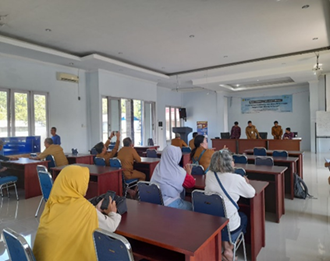Focus Group Discussion Penerapan Bioteknologi dalam Budidaya Ikan sebagai Upaya Peningkatan Produktivitas Perikanan di Kecamatan Anjongan, Kabupaten Mempawah Focus Group Discussion Application of Biotechnology in Fish Cultivation as a Way to Increase Fishery Productivity in Anjongan District, Mempawah Regency
Main Article Content
Abstract
BPS data for Mempawah Regency shows that aquaculture production in the Anjongan District is 163 tons/year. This production result is still lower compared to other sub-districts. One of the factors causing the not-yet-optimal effects of aquaculture production in the Anjongan District is the limited mastery of aquaculture technology. Biotechnology in the field of fisheries offers sustainable technology to increase fishery resources. This Community Service aims to conduct a Focus Group Discussion on plans to apply biotechnology in fish farming. In this activity, several applications of biotechnology in aquaculture were presented. The results of the discussion activities revealed several problems, including limited sources of clean water for fish farming, high costs for feed, and limited resources for implementation in the field of biotechnology. Feed is a top priority and an essential factor because fish can grow in a healthy, optimal, and quality manner.
Downloads
Article Details

This work is licensed under a Creative Commons Attribution-ShareAlike 4.0 International License.
Authors who publish with this journal agree to the following terms:
- Any article on the copyright is retained by the author(s).
- Author grant the journal, right of first publication with the work simultaneously licensed under a Creative Commons Attribution License that allows others to share work with acknowledgment of the work authors and initial publications in this journal.
- Authors are able to enter into a separate, additional contractual arrangements for non-exclusive distribution of published articles of work (eg, post-institutional repository) or publish it in a book, with acknowledgment of its initial publication in this journal.
- Authors are permitted and encouraged to post their work online (e.g., in institutional repositories or on their websites) prior to and during the submission process, as can lead to productive exchanges, as well as earlier and greater citation of published work.
- The article and any associated published material is distributed under the Creative Commons Attribution-ShareAlike 4.0 International License
References
Badan Pusat Statistik (BPS). (2022). Produksi Provinsi (Ton) 2019-2021, Jakarta.
Chakraborty, S. B. D., Mazumdar, U., Chatterji., Banerjee, S. (2011). Growth of Mixed-Sex and Monosex Nile Tilapia in Different Culture Systems. Turkish Journal of Fisheries and Aquatic Sciences,11: 131-138. 10.4194/trjfas.2011.0117
Dewi, Ilanka Cahya, and Nira Rahanta Nurul Auliyyah. 2020. “Penyuluhan Stunting Sebagai Sarana Untuk Meminimalisir Tingginya Angka Stunting Di Desa Gambiran Kecamatan Kalisat.” JIWAKERTA: Jurnal Ilmiah Wawasan Kuliah Kerja Nyata 1(2):25–29. https://doi.org/10.32528/jiwakerta.v1i2.5010
Dewi, Rosmala, Meriem Meisyaroh, and Kassaming. 2021. “Penyuluhan Kesehatan Terhadap Pengetahuan Lanjut Usia Tentang Penyakit Degeneratif Di Wilayah Kerja Puskesmas Baranti.” Jurnal Inovasi Dan Pengabdian Masyarakat (JIPengMas) 1(1):8–13. https://doi.org/10.31629/anugerah.v5i1.5568
Dunham, R. A. (2009). Transgenic Fish Resistant to Infectious Diseases, Their Risk and Prevention of Escape Into the Environment and Future Candidate Genes for Disease Transgene Manipulation. Comparative Immunology, Microbiology and Infectious Diseases, 32: 139-161. https://doi.org/10.1016/j.cimid.2007.11.006
Gjedrem, T., Robinson, N., Rye, M. (2012). The Importance of Selective Breeding in Aquaculture to Meet Future Demands for Animal Protein: A Review. Aquaculture, 117-129. https://doi.org/10.1016/j.aquaculture.2012.04.008
Iman, Aldo Muhammad, and Risda Arba Ulfi. 2021. “Pengabdian Masyarakat Dengan Meningkatkan Minat Anak-Anak Terhadap Pentingnya Pendidikan Di Kampung Pondok Manggis, Bojong Gede.” Proceedings UIN Sunan Gunung Djati Bandung 1(58).
Laporan Keterangan Pertanggungjawaban Kalimantan (LKPJ) Kalimantan Barat tahun 2019. (2019). Pemerintah Daerah Kalimantan Barat.
Lestari, Anik, and Diffah Hanim. (2020). “Edukasi Kader Dalam Upaya Pencegahan Dan Penanggulangan Stunting Di Kecamatan Mondokan Kabupaten Sragen.” AgriHealth: Journal of Agri-Food, Nutrition and Public Health 1(1):7. doi: 10.20961/agrihealth.v1i1.41106. https://doi.org/10.20961/agrihealth.v1i1.41106
Mukti, A. T. (2005). Perbedaan Keberhasilan Tingkat Poliploidisasi Ikan Mas (Cyprinus carpio Linn.) Melalui Kejutan Panas. Berkala Penelitian Hayati, 10: 133–138. https://doi.org/10.23869/447
Nahdi, Dede Salim, Abdur Rasyid, and Ujiati Cahyaningsih. 2020. “Meningkatkan Kompetensi Profesional Guru Melalui Pengembangan Media Pembelajaran Berbasis Teknologi Informasi.” BERNAS: Jurnal Pengabdian Kepada Masyarakat 1(2):76–81. https://doi.org/10.31949/jb.v1i2.234
Nayak, S.K. (2010). Probiotics and Immunity: a Fish Perspective. Fish and Shellfish Immunology, 29: 2–14. https://doi.org/10.1016/j.fsi.2010.02.017
Nurasni, A. (2012). Pengaruh Suhu dan Lama Kejutan Panas Terhadap Triploidisasi Ikan Lele Sangkuriang (Clarias gariepinus). Indonesian Journal of Applied Sciences, 2(1):19–26. https://doi.org/10.24198/ijas.v2i1.2728
Prayogo, N.A., Sukardi, P., Sahri, A., Siregar. (2022). Peningkatan Keterampilan Petani pada Usaha Budidaya Ikan Lele dengan Teknologi Kawin Suntik. DINAMISIA : Jurnal Pengabdian Kepada Masyarakat, 6(6): 1612-1616. https://doi.org/10.31849/dinamisia.v6i6.7825
Puspitasari, Ayu, Wudi Darul Putra, and Haeril Amir. (2021). “Pencegahan Stunting Pada Anak Di Desa Tamangapa Kec. Ma’rang Kab. Pangkep.” Idea Pengabdian Masyarakat 1(1):05–08. https://doi.org/10.53690/ipm.v1i1.3
Rophi, Apriani Herni, and Paula Nancy Lefaan. (2023). “Pelatihan Pembuatan Tepung Tulang Ikan Sebagai Pemanfaatan Limbah Perikanan Di Distrik Demta, Provinsi Papua.” Community Development Journal : Jurnal Pengabdian Masyarakat 4(2):2345–51.
Soedibya P.H.T., Pramono, T.B., Santoso, M. (2009). Aquaculture : Pro Poor, Pro Job and Pro Growth. Aquaculture : Pro Poor Pro Job and Pro Growth (Case Empowerment In Purbalingga). Paper Presented in Internasional Seminar Fisheries and Marine. Airlangga University.
Suman, A. (2016). Potensi dan Tingkat Pemanfaatan Sumber Daya Ikan di WPP-NRI 2015. Makalah Disampaikan pada Sidang Tahunan Komnas Kajiskan. Balai Penelitian Perikanan Laut, Puslitbangkan, Balitbang KP.
Trianto. (2018). Mendesain Model Pembelajaran Inovatif – Progresif. Jakarta: Kharisma Putra Grafika.
Verschuere L, Rombaut G, Sorgeloos P, Verstraete W. (2000). Probiotic bacteria as biological control agents in Aquaculture. Microbiolgical and Molecular Biology Review, 64: 655–671. https://doi.org/10.1128%2Fmmbr.64.4.655-671.2000
Wahyurin, Izka Sofiyya, Arfiyanti Nur Aqmarina, Hiya Alfi Rahmah, Ade Uswatun, Hasanah, and Christy Nataly Br Silaen. (2019). “Pengaruh Edukasi Stunting Menggunakan Metode Brainstorming Dan Audiovisual Terhadap Pengetahuan Ibu Dengan Anak Stunting.” Ilmu Gizi Indonesia 2(2):141–46. https://doi.org/10.35842/ilgi.v2i2.111
